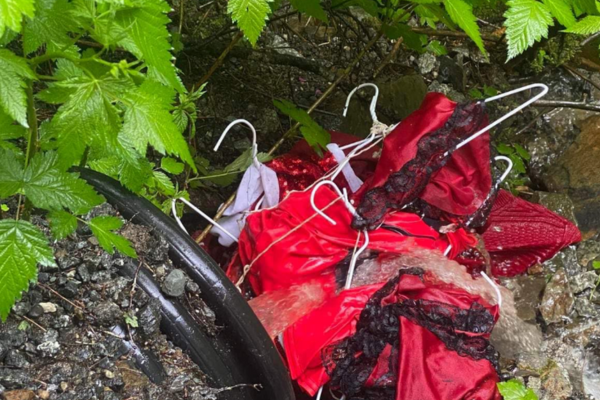
- Details
- By Elyse Wild
The garments were installed on May 15 to commemorate MMIP Awareness Month under a permit KIC held from the U.S. Forestry Service. By the time the installation was scheduled to come down on May 31, 48 of the dresses were missing. In recent days, photos have been surfacing on social media showing some of the dresses crumpled near the lakeside trail, half buried or discarded in piles near drain pipes.
The tribe’s council issued a statement condemning “a hurtful and disrespectful act that undermines the efforts to bring understanding and raise awareness about the MMIP epidemic.”
Similar installations are featured throughout Canada and the United States during May to bring awareness to the disproportionate number of Indigenous people who are victims of violent crimes or go missing.
Murder is the third leading cause of death for Native women, with the murder rate ten times higher than the national average for women living on reservations, according to the Centers for Disease Control and Prevention. In 2021, Alaska reported 229 cases of missing and murdered Indigenous persons — 149 missing and 80 murdered.
Gloria Burns, KIC’s vice president and the chair of the social services committee, told local radio station KRBD that the tribe hung the dresses with remembrance and intention in an effort to create a “safe space.”
“And so when you’re going through that process of trying to create a safe space, and then it’s intentionally made unsafe, it feels very much like a violation,” Burns told KRBD. “I think, you know, the hard part is that missing and murdered indigenous people, it’s been happening since colonization, we really don’t talk about it. We really haven’t spoken those to the outside community.”
Anyone with information on the vandalization is encouraged to contact local law enforcement.
More Stories Like This
Native News Weekly (August 25, 2024): D.C. BriefsUS Presidents in Their Own Words Concerning American Indians
Next on Native Bidaské: A Conversation with Indian Gaming Association Chairman David Bean
US Senate Unanimously Recognizes November as National Native American Heritage Month
Navajo Council Focuses on Improving Senior Services, SNAP Access for Elders
Help us tell the stories that could save Native languages and food traditions
At a critical moment for Indian Country, Native News Online is embarking on our most ambitious reporting project yet: "Cultivating Culture," a three-year investigation into two forces shaping Native community survival—food sovereignty and language revitalization.
The devastating impact of COVID-19 accelerated the loss of Native elders and with them, irreplaceable cultural knowledge. Yet across tribal communities, innovative leaders are fighting back, reclaiming traditional food systems and breathing new life into Native languages. These aren't just cultural preservation efforts—they're powerful pathways to community health, healing, and resilience.
Our dedicated reporting team will spend three years documenting these stories through on-the-ground reporting in 18 tribal communities, producing over 200 in-depth stories, 18 podcast episodes, and multimedia content that amplifies Indigenous voices. We'll show policymakers, funders, and allies how cultural restoration directly impacts physical and mental wellness while celebrating successful models of sovereignty and self-determination.
This isn't corporate media parachuting into Indian Country for a quick story. This is sustained, relationship-based journalism by Native reporters who understand these communities. It's "Warrior Journalism"—fearless reporting that serves the 5.5 million readers who depend on us for news that mainstream media often ignores.
We need your help right now. While we've secured partial funding, we're still $450,000 short of our three-year budget. Our immediate goal is $25,000 this month to keep this critical work moving forward—funding reporter salaries, travel to remote communities, photography, and the deep reporting these stories deserve.
Every dollar directly supports Indigenous journalists telling Indigenous stories. Whether it's $5 or $50, your contribution ensures these vital narratives of resilience, innovation, and hope don't disappear into silence.
 The stakes couldn't be higher. Native languages are being lost at an alarming rate. Food insecurity plagues many tribal communities. But solutions are emerging, and these stories need to be told.
The stakes couldn't be higher. Native languages are being lost at an alarming rate. Food insecurity plagues many tribal communities. But solutions are emerging, and these stories need to be told.
Support independent Native journalism. Fund the stories that matter.
Levi Rickert (Potawatomi), Editor & Publisher

